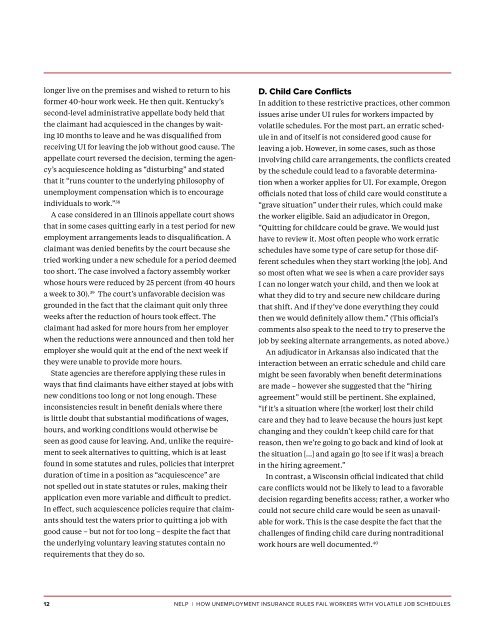Out of Sync
Out-of-Sync-Report
Out-of-Sync-Report
- No tags were found...
You also want an ePaper? Increase the reach of your titles
YUMPU automatically turns print PDFs into web optimized ePapers that Google loves.
longer live on the premises and wished to return to hisformer 40-hour work week. He then quit. Kentucky’ssecond-level administrative appellate body held thatthe claimant had acquiesced in the changes by waiting10 months to leave and he was disqualified fromreceiving UI for leaving the job without good cause. Theappellate court reversed the decision, terming the agency’sacquiescence holding as “disturbing” and statedthat it “runs counter to the underlying philosophy <strong>of</strong>unemployment compensation which is to encourageindividuals to work.” 38A case considered in an Illinois appellate court showsthat in some cases quitting early in a test period for newemployment arrangements leads to disqualification. Aclaimant was denied benefits by the court because shetried working under a new schedule for a period deemedtoo short. The case involved a factory assembly workerwhose hours were reduced by 25 percent (from 40 hoursa week to 30). 39 The court’s unfavorable decision wasgrounded in the fact that the claimant quit only threeweeks after the reduction <strong>of</strong> hours took effect. Theclaimant had asked for more hours from her employerwhen the reductions were announced and then told heremployer she would quit at the end <strong>of</strong> the next week ifthey were unable to provide more hours.State agencies are therefore applying these rules inways that find claimants have either stayed at jobs withnew conditions too long or not long enough. Theseinconsistencies result in benefit denials where thereis little doubt that substantial modifications <strong>of</strong> wages,hours, and working conditions would otherwise beseen as good cause for leaving. And, unlike the requirementto seek alternatives to quitting, which is at leastfound in some statutes and rules, policies that interpretduration <strong>of</strong> time in a position as “acquiescence” arenot spelled out in state statutes or rules, making theirapplication even more variable and difficult to predict.In effect, such acquiescence policies require that claimantsshould test the waters prior to quitting a job withgood cause – but not for too long – despite the fact thatthe underlying voluntary leaving statutes contain norequirements that they do so.D. Child Care ConflictsIn addition to these restrictive practices, other commonissues arise under UI rules for workers impacted byvolatile schedules. For the most part, an erratic schedulein and <strong>of</strong> itself is not considered good cause forleaving a job. However, in some cases, such as thoseinvolving child care arrangements, the conflicts createdby the schedule could lead to a favorable determinationwhen a worker applies for UI. For example, Oregon<strong>of</strong>ficials noted that loss <strong>of</strong> child care would constitute a“grave situation” under their rules, which could makethe worker eligible. Said an adjudicator in Oregon,“Quitting for childcare could be grave. We would justhave to review it. Most <strong>of</strong>ten people who work erraticschedules have some type <strong>of</strong> care setup for those differentschedules when they start working [the job]. Andso most <strong>of</strong>ten what we see is when a care provider saysI can no longer watch your child, and then we look atwhat they did to try and secure new childcare duringthat shift. And if they’ve done everything they couldthen we would definitely allow them.” (This <strong>of</strong>ficial’scomments also speak to the need to try to preserve thejob by seeking alternate arrangements, as noted above.)An adjudicator in Arkansas also indicated that theinteraction between an erratic schedule and child caremight be seen favorably when benefit determinationsare made – however she suggested that the “hiringagreement” would still be pertinent. She explained,“if it’s a situation where [the worker] lost their childcare and they had to leave because the hours just keptchanging and they couldn’t keep child care for thatreason, then we’re going to go back and kind <strong>of</strong> look atthe situation […] and again go [to see if it was] a breachin the hiring agreement.”In contrast, a Wisconsin <strong>of</strong>ficial indicated that childcare conflicts would not be likely to lead to a favorabledecision regarding benefits access; rather, a worker whocould not secure child care would be seen as unavailablefor work. This is the case despite the fact that thechallenges <strong>of</strong> finding child care during nontraditionalwork hours are well documented. 4012 NELP | HOW UNEMPLOYMENT INSURANCE RULES FAIL WORKERS WITH VOLATILE JOB SCHEDULES


